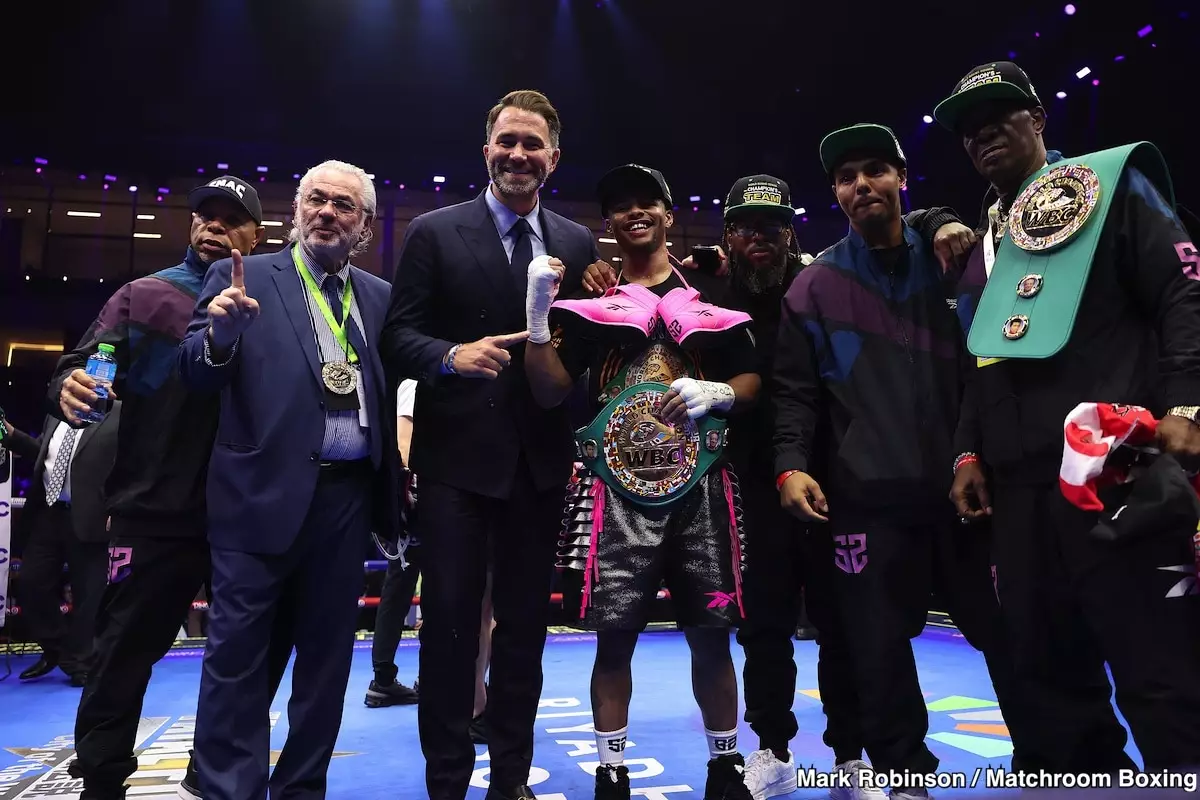The anticipated clash between WBC lightweight champion Shakur Stevenson and interim champion William Zepeda could soon materialize, potentially setting the stage in Newark, New Jersey—Stevenson’s home turf. Promoter Eddie Hearn has expressed confidence in making this fight a reality, suggesting a collaborative effort with Golden Boy Promotions. Through dialogues with Golden Boy president Eric Gomez, Hearn’s vision includes a broader event, hinting at a “5v5” fight card that aims to elevate the boxing landscape. This vision also seeks to pave the way for a significant unification match, presumably targeting thrilling matchups that could define the lightweight division.
Hearn’s assertions reflect the brewing excitement in boxing circles. The prospects of hosting a major fight in Newark come with historical weight, as Shakur Stevenson has consistently demonstrated a capacity to draw impressive crowds, frequently surpassing the million-dollar mark in gate revenues. However, this ambition encounters hurdles, especially given Zepeda’s profile and the potential implications for both fighters’ careers. Zepeda represents a formidable challenge—one that not only tests Stevenson’s readiness but also his ability to regain the attention of a fan base that has soured after his recent performances.
Shakur Stevenson’s Stamina and Marketability Concerns
Despite Hearn’s bullish stance, Stevenson finds himself in a precarious situation, grappling with the dual pressures of reclaiming his marketability and navigating the strategic complexities of the lightweight division. His recent endeavors, notably a less-than-stellar showdown with Edwin De Los Santos in 2023, have diminished his standing. Herein lies the irony: while a fight against the electrifying Zepeda seems appealing, it also places Stevenson at risk of further alienation from followers who yearn for excitement rather than tactical retreats.
Stevenson’s propensity for a hit-and-run strategy—an approach that worked in past bouts—might not serve him well against Zepeda, whose relentless intensity and high punch output pose a significant threat. If Stevenson aims to simply outmaneuver Zepeda, risking a duller display in the process may only exacerbate his struggle to reignite the buzz around his name. Analysts are left to ponder whether he can adapt his style effectively to engage an audience while contending with Zepeda’s relentless onslaught.
The Undercard Opportunity: Engaging New Fans
Hearn’s mention of a potential “5v5” fight card cannot be dismissed lightly. It represents a strategic attempt to cultivate fan interest through varied matchups, potentially enlisting fighters across different promotional banners. This could be a pivotal move to capture a fresh audience, especially among younger fans who thrive on entertainment. Integrating diverse bouts might not only invigorate the event but also support Stevenson’s quest to establish a reputation for thrilling encounters.
Yet, the skepticism surrounding the feasibility of this proposed fight card remains. While promoting collaboration between promotional entities is noble, financial and contractual realities often dictate the success of such initiatives. Zepeda’s management might view a matchup in Newark as unbeneficial unless the financial incentives align favorably. Finding common ground in purse splits could prove challenging, especially under the overarching influence of the lucrative Saudi boxing scene, where fighters have grown accustomed to premium paychecks.
Falling Star or Rising Champion? The Stakes of Big Fights
The stark divide between Stevenson’s current standing and his aspirations for unification bouts encapsulates a broader debate in boxing. Advocates argue that Stevenson possesses the skills necessary to ascend once more—provided he secures a decisive win over Zepeda. In contrast, skeptics caution that the nuances involved in high-stakes boxing demand more than technical prowess; they call for charisma and exponential fan engagement, which Stevenson’s recent bouts have not cultivated effectively.
Ultimately, the critical question emerges: Can Stevenson revitalize his image and elevate his promotional value in this potentially career-defining bout? His ability to counteract the limitations of his prior performances will be vital. A victory that showcases aggression, creativity, and crowd-pleasing elements could serve as the catalyst for a hyped matchup against Gervonta Davis—an event with implications far beyond the ring.
Financial Dynamics in Boxing’s Transformation
Hearn acknowledges the financial disparity between events conducted in traditional venues versus those hosted in Saudi Arabia, illustrating an industry grappling with shifting economic landscapes. The allure of Saudi Arabia, with its robust financial backing for boxing events, raises pertinent questions about the sustainability of U.S.-based promotions. If Zepeda and his camp remain hesitant about a Newark showdown, a Saudi opportunity might be deemed irresistible, reflecting the relentless drive of boxing towards ever-increasing financial stakes.
Without injections of significant financial support, whether from Saudi sources or otherwise, it is questionable whether Zepeda will acquiesce to a proposed fight in Newark—an outcome Hearn appears optimistic about but many in the boxing community view with skepticism. The boxing stage is set for a confrontation that could determine both fighters’ trajectories, yet the intricacies governing such negotiations emphasize the need for strategic foresight amidst a landscape characterized by ambition and reality.

